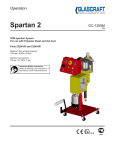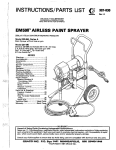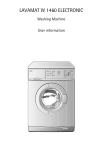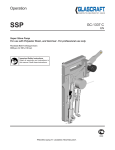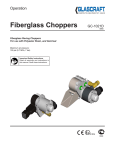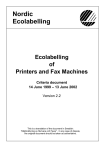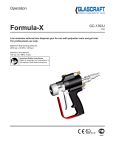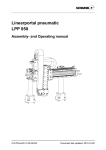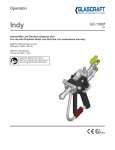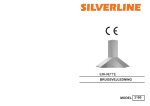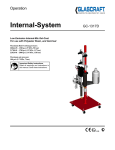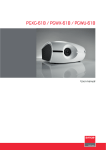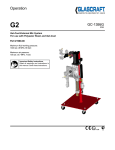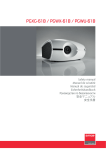Download GC-1202E Glascraft Spartan, Opertion, English
Transcript
Operation Spartan GC-1202E EN RTM Injection System For use with Polyester Resin and Gel-Coat Part 21650-00 Maximum fluid working pressure: 1300 psi. (9 MPa, 90 bar) Maximum air pressure: 100 psi. (0.7 MPa, 7 bar) Important Safety Instructions Read all warnings and instructions in this manual. Save these instructions. II 2 G Contents Warnings Warnings ............................................................................................................................................................ Important Safety Information .............................................................................................................................. Grounding ........................................................................................................................................................... 3 5 6 Set-up Set-up Instructions ............................................................................................................................................. Pressure Relief Instructions ............................................................................................................................... Start-up Instructions ........................................................................................................................................... Shut-down Instructions ....................................................................................................................................... Parts ................................................................................................................................................................... Assembly Drawings ............................................................................................................................................ Sub-Assembly Drawings .................................................................................................................................... 7 9 10 16 17 18 24 Maintenance Maintenance ....................................................................................................................................................... 30 Technical Data Technical Data .................................................................................................................................................. Graco Ohio Standard Warranty................................................................................................... Graco Ohio Information ............................................................................................................. 31 32 32 N/A = Non Applicable 2 GC-1202E Warnings The following warnings are for the setup, use, grounding, maintenance, and repair of this equipment. The exclamation point symbol alerts you to a general warning and the hazard symbol refers to procedurespecific risk. Refer back to these warnings. Additional, product-specific warnings may be found throughout the body of this manual where applicable. • See Important Safety Information - MEKP, Polyester Resins and Gel-Coats and Spraying and Lamination Operations section of this manual. Changing Materials Changing Materials WARNING • When changing materials, flush the equipment multiple times to ensure it is thoroughly clean. FIRE AND EXPLOSION HAZARD • prevent and explosion: Always clean thefire fluid inlet strainers after flushing. Flammable fumes, such as solvent and paint fumes, in work area can ignite or explode. To help • • • • Use equipment only in well ventilated area. • Eliminate all ignition sources; for such as pilot lights, cigarettes, portable electric lamps, and plastic Check with your material manufacturer chemical drop cloths (potential static arc). compatibility. • Keep work area free of debris, including solvent, rags and gasoline. • Do not plug or unplug power cords, or turn power or light switches on or off when flammable Most materials useare ISO on the A side, but some use fumes present. ISO on the B side. • Ground all equipment in the work area. See Grounding instructions. • Use only grounded hoses. Epoxies•often have theofBgrounded (hardener) Hold gunamines firmly toon side pail when triggering into pail. • If there is static or you a shock, stop operation immediately. Do not use side. Polyureas often have sparking amines on the feel B (resin) equipment until you identify and correct the problem. side. • Keep a working fire extinguisher in the work area. PERSONAL PROTECTIVE EQUIPMENT You must wear appropriate protective equipment when operating, servicing, or when in the operating area of the equipment to help protect you from serious injury, including eye injury, This section inhalation is used with somefumes, RAM burns, plates and which couldloss. get pushed out of the drumsbut of is sealant. of toxic hearing This equipment includes not limited to: • Protective eyewear • Clothing and respirator as recommended by the fluid and solvent manufacturer • Gloves • Hearing protection Splatter Hazard WARNING TOXIC FLUID OR FUMES HAZARD SPLATTER Toxic fluids HAZARD or fumes can cause serious injury or death if splashed in the eyes or on skin, inhaled, or Hot or toxic fluid can cause serious injury if splashed in the eyes or on skin. During blow off of platen, swallowed. • Read MSDS’s splatter may occur.to know the specific hazards of the fluids you are using. Store hazardous in approved containers,platen and dispose of it according to applicable • • Use minimum airfluid pressure when removing from drum. • guidelines. Always wear impervious gloves when spraying or cleaning equipment. Burn Hazard For equipment used with heated material. GC-1202E WARNING 3 BURN HAZARD - Hot Surfaces Equipment surfaces and fluid that’s heated can become very hot during operation. To avoid severe burns: • Do not touch hot fluid or equipment. Skin Injection Hazard Use with high pressure equipment, generally equipment with pressure rating of 900 psi or higher. There sions of this section. 1) manual guns, 2) UL-1450 compliant equipment 3) automatic guns,/dispense val Warnings tion valves, 4) heated hoses. Since the text contains mostly “Do not” statements, the symbols have lines them. WARNING WARNING SKIN HAZARD SKININJECTION INJECTION HAZARD - Basic High-pressure fluid from gun, hose leaks, or ruptured components will pierce skin. This may look High-pressure fluid from gun, hose leaks, or ruptured components will pierce skin. This may l like just a cut, but it is a serious injury that can result in amputation. Get immediate surgical a cut, but it is a serious injury that can result in amputation. Get immediate surgical treatm treatment. point gun at anyone at of any •• DoDo notnot point gun at anyone or at anyorpart thepart body.of the body. •• DoDo notnot put put youryour hand hand over the dispense outlet. tip. over the spray •• DoDo notnot stopstop or deflect leaks with yourwith hand, body, glove,body, or rag.glove, or rag. or deflect leaks your hand, •• Engage trigger lock when not Do not spray without tipspraying. guard and trigger guard installed. •• Follow Pressure Relief Procedure in spraying. this manual, when you stop spraying and before cleaning, Engage trigger lock when not checking, or servicing equipment. • Follow Pressure Relief Procedure in this manual, when you stop spraying and before c checking, or servicing equipment. MOVING PARTS HAZARD SKIN Use with UL1450 Compliance Moving INJECTION parts can pinchHAZARD or amputate- fingers and other body parts. not aim gun at,parts. or spray any person or animal. •DoKeep clearthe of moving •• DoKeep not operate equipment with protective covers hands and other body partsguards awayor from theremoved. discharge. For example, do not try to sto • Pressurized equipment can start without warning. Before checking, moving, or servicing any part of the body. equipment, follow the Pressure Relief Procedure in this manual. Disconnect power or air • supply. Always use the nozzle tip guard. Do not spray without nozzle tip guard in place. • Use Graco nozzle tips. •EQUIPMENT Use caution when cleaning and changing nozzle tips. in the case where the nozzle tip clo MISUSE HAZARD spraying, follow the Pressure Misuse can cause death or serious injury. Relief Procedure for turning off the unit and relieving the • Dobefore not operate the unitthe when fatigued the influence of drugs or alcohol. removing nozzle tiportounder clean. Fire and Explosion Hazard •• DoDo notnot exceed thethe maximum working pressure or temperature the lowest rated system leave unit energized or under pressure rating whileofunattended. When the unit is not component. See Technical Data in all equipment manuals. off the unit and follow the Pressure Relief Procedure for turning off the unit. • Use fluids and solvents that are compatible with equipment wetted parts. See Technical Data • in High-pressure sprayRead is able inject toxins into the body andFor cause serious bodily injury. all equipment manuals. fluidto and solvent manufacturer’s warnings. complete Pressurized Aluminum Parts Hazard that injection occurs, get request immediate information about your material, MSDS surgical forms from treatment. distributor or retailer. • Check hoses and parts for signs of damage. Replace any damaged hoses or parts. • Check equipment daily. Repair or replace worn or damaged parts immediately with genuine replacement parts only.parts only. Use with equipment pressurized aluminum Equipment havereplacement aluminum parts thatoraren’t pres • manufacturer’s Thiswith system is capable of producing XXXX psi. Usemay Graco parts accesso Dorated not alter or modify equipment. ized - check• with engineering. a minimum of XXXX psi. • Use equipment only for its intended purpose. Call your distributor for information. • Always engage the trigger lock when not spraying. Verify the trigger lock is functioning pr • Route hoses and cables away from traffic areas, sharp edges, moving parts, and hot surfaces. • that all connections operating the unit. • DoVerify not kink or over bend hoses orare use secure hoses to before pull equipment. Know howand to stop theaway unitfrom andwork bleed pressure quickly. Be thoroughly familiar with the con •• Keep children animals area. • WARNING Comply with all applicable safety regulations. PRESSURIZED ALUMINUM PARTS HAZARD PRESSURIZED ALUMINUM PARTS HAZARD Do not use 1,1,1-trichloroethane, methylene chloride, other halogenated hydrocarbon solvents or Do notcontaining use 1,1,1-trichloroethane, methylenealuminum chloride,equipment. other halogenated solvents or fluid fluids such solvents in pressurized Such use hydrocarbon can cause serious chemical reaction and equipment rupture, and result in death, seriousSuch injury,use andcan property damage. containing such solvents in pressurized aluminum equipment. cause serious chemical reaction and equipment rupture, and result in death, serious injury, and property damage. 4 Plastic Parts Cleaning Solvent Hazard GC-1202E Created for CEDs Texture Sprayer. May have use with other waterbase application equipment with plastic parts th can be damaged by certain solvents. Important Safety Information Methyl Ethyl Ketone Peroxide (MEKP) MEKP is among the more hazardous materials found in commercial channels. Proper handling of the “unstable (reactive)” chemicals presents a definite challenge to the plastics industry. The highly reactive property which makes MEKP valuable to the plastics industry in producing the curing reaction of polyester resins and gel-coats also produces the hazards which require great care and caution in its storage, transportation, handling, processing and disposal. Workers must be thoroughly informed of the hazards that may result from improper handling of MEKP, especially in regards to contamination and heat. They must be thoroughly instructed regarding the proper action to be taken in the storage, use and disposal of MEKP and other hazardous materials used in the laminating operation. MEKP is flammable and potentially explosive, as well as potentially damaging to the eyes and skin. Read material manufacturer’s warnings and material MSDS to know specific hazards and precautions related to MEKP. Contaminated MEKP can become explosive. Prevent contamination of MEKP with other materials, which includes, but is not limited to polyester overspray, polymerization accelerators and promoters, and non-stainless metals. Even small amounts of contaminates can make MEKP explosive. This reaction may start slowly, and gradually build-up heat, which can accelerate until fire or an explosion result. This process can take from seconds to days. Heat applied to MEKP, or heat build-up from contamination reactions can cause it to reach what is called its Self-Accelerating Decompisition Temperature (SADT), which can cause fire or explosion. Spills should be promptly removed, so no residues remain. Spillage can heat up to the point of selfignition. Dispose in accordance with manufacture’s recommendation. Store MEKP in a cool, dry and well-ventilated area in the original containers away from direct sunlight and away from other chemicals. It is strongly recommended that the storage temperature remain below 86° F (30° C). Heat will increase the potential for explosive decomposition. Refer to NFPA 432. Keep MEKP away from heat, sparks and open flames. GC-1202E Current catalysts are premixed and do not require any diluents. GlasCraft strongly recommends that diluents not be used. Diluants add to the possibility of contaminates entering the catalyst system. Never dilute MEKP with acetone or any solvent since this can produce an extremely shock-sensitive compound which can explode. Use only original equipment or equivalent parts from GlasCraft in the catalyst system (i.e.: hoses, fittings, etc.) because a hazardous chemical reaction Spraying materials containing isocyanates creates may result between substituted parts and MEKP. potentially mists, vapors, and atomized To preventharmful contact with MEKP, appropriate personalparticulates. protective equipment, including chemically impermeable gloves, boots, aprons and goggles are required Read material manufacturer’s for everyone in the work area. warnings and material MSDS to know specific hazards and precautions related to isocyanates. Isocyanate Conditions Polyester Resins and Gel-Coats Prevent inhalation of isocyanate mists, vapors, and atomized particulates by providing sufficient ventilation in the work area. If sufficient ventilation is not available, a supplied-air respirator is required for Sprayinginmaterials containing everyone the work area. polyester resin and gel-coats creates potentially harmful mist, vapors and atomized particulates. Prevent inhalationappropriate by providing perTo prevent contact with isocyanates, sufficient ventilation and the use of respirators in the sonal protective equipment, including chemically work area. impermeable gloves, boots, aprons, and goggles, is Read the material manufacturer’s and maalso required for everyone in the warnings work area. terial MSDS to know specific hazards and precautions related to polyester resins and gel-coats. To prevent contact with polyester resins and gelcoats, appropriate personal protective equipment, including chemically impermeable gloves, boots, aprons and goggles are required for everyone in the work area. • • • • • • K B Material Self-ignition To we an Some materials may become self-igniting if applied too thickly. Read manufacturer’s warnings Spraying and material Lamination Operations and material MSDS. Fo B Moisture Sensitivity of Remove all accumulations of overspray, FRP sandIsocyanites ings, etc. from the building as they occur. If this waste is allowed to build are up, spillage of used catalyst more likely Isocyanites (ISO) catalysts in istwo component to start a fire. foam and polyurea coatings. ISO will react with moisture If cleaning solvents are required, read material (such as humidity) to form small, hard, abrasive crystals, manufacture’s warnings and material MSDS to know a film which become suspended in the fluid. Eventually specific hazards and precautions. (GlasCraft recomwill form on the surface and the ISO will begin to gel, mends that clean-up solvents be nonflammable.) increasing in viscosity. If used, this partially cured ISO will reduce performance and the life of all wetted parts. GlasCraft recommends that you consult OSHA The amount of film formation and rate of crystalliSections 1910.94, 1910.106, 1910.107 and NFPA zation varies depending on the blend of ISO, the No. 33, Chapter 16,17, and NFPA No. 91 for further humidity, and the temperature. guidance. To prevent exposing ISO to moisture: 5 Som abo if ag circ Grounding Some materials may become self-igniting if applied too thickly. Read material manufacturer’s warnings and material MSDS. Moisture Sensitivity of This equipment needs to be grounded. Isocyanites Isocyanites aregun catalysts in twoto component Ground the(ISO) dispense throughused connection a foam and polyurea react with moisture GlasCraft approvedcoatings. grounded ISO fluid will supply hose. (such as humidity) to form small, hard, abrasive crystals, which become suspended in the fluid. Eventually Check your local electrical code and related manuals a film will on the surface and the ISO begin toingel, forform detailed grounding instructions of allwill equipment increasing in viscosity. If used, this partially cured ISO the work area. will reduce performance and the life of all wetted parts. NOTICE To prevent cross-contamination of the equipment’s wetted parts, never interchange component A (isocyanate) and component B (resin) parts. Foam Resins with 245 fa Blowing Agents Some foam blowing agents will froth at temperatures above 90°F (33°C) when not under pressure, especially if agitated. To reduce frothing, minimize preheating in a circulation system. The amount of film formation and rate of crystalliA grounding and clamp provided, zation varieswire depending onare the blend of ISO, the assembly p/n 17440-00 with all FRP equipment. humidity, and the temperature. To prevent exposing ISO to moisture: Rev. G 6/17/2008 6 21 GC-1202E MSDS to know specific hazards and precautions Moisture Sensitivity of related to isocyanates. Isocyanites Prevent inhalation of isocyanate mists, vapors, and Isocyanites (ISO) are catalysts used in two component Set-Upparticulates atomized by providing sufficient ventilafoam and polyurea coatings. ISO will react with moisture tion in the work area. If sufficient ventilation is not (such humidity) tocomplete form small, abrasive crystals, The as Spartan comes and hard, fitted with all for available, a supplied-air respirator is required which become suspended in the fluid. Eventually a film resin hoses, catalyst everyone in the workbottle area.and filters. The injection willhead form on the surface and the ISO will begin to gel, is fully connected to the machine circuit and increasing viscosity. If used, partially cured ISO tested andin secured against leaksthis prior to dispatch. To prevent contact with isocyanates, appropriate perwill reduce performance and the life of all wetted parts. sonal protective equipment, including chemically impermeable gloves, boots, aprons, and goggles, is The amount of film formation and rate The following instructions are to be used asofacrystalliguide also required for everyone in the work area. zation varies depending on the blend of ISO, for consistent and continual operation. Any devia-the humidity, and“standard the temperature. tion from the operation”, usually requires more maintenance to the equipment and material To prevent exposing ISO to moisture: formulation to assure consistent results. For example: the use of fillers in resins. Material Self-ignition 1. Select a clean, dry air supply. Rev. G 6/17/2008 2. Attach a 3/8” or larger air hose to the Air Inlet on the Some materials may become self-igniting if applied yellow air lock-out valve. too thickly. Read material manufacturer’s warnings and material MSDS. Some foam blowing agents will froth at temperatures 90°F (33°C) whensolvents, not underwhich pressure, especially • above Never use reclaimed may contain if agitated. ToAlways reducekeep frothing, minimize preheating moisture. solvent containers closedin a circulation system. when not in use. • Never use solvent on one side if it has been contaminated from the other side. • Always lubricate threaded parts with ISO pump oil or grease when reassembling. Keep Components A and B Separate NOTICE To prevent cross-contamination of the TO equipment’s SLAVE PUMP wetted parts, never interchange component A (isocy2 anate) and component B (resin) parts. Foam Resins with 245 fa Blowing Agents Whenever flammable or combustible liquids are transfered from one container to another, both containers Fire and Explosion Hazard shall be effectively bonded and grounded to dissipate foam blowing agents will froth at temperatures staticSome electricity. above 90°F (33°C) when not under pressure, especially For further information see..... Skin Injection Hazard agitated. To reduce frothing, minimize preheating in a NFPAif 77,Recommended Practice on Static Electricity. Use with high pressure equipment, generally equipment with pressurecirculation rating of 900 psisystem. or higher. There are 2 verIsocyanites (ISO) sions areofcatalysts two component this section. 1)used manual in guns, 2) UL-1450 compliant equipment 3) automatic guns,/dispense valves,/lubricafoam and polyureationcoatings. ISO willSince react with moisture valves, 4) heated hoses. the text contains mostly “Do not” statements, the symbols have lines through (such as humidity)them. to form small, hard, abrasive crystals,5. Remove the pump inlet saftey cap and drain the testing oil into an open container. which become suspended in the fluid. Eventually a film will form on the surface and the ISO will begin to gel, increasing in viscosity. If used, this partially cured ISO 6. Attach 4 casters with provided lock washer, washer and will reduce performance and the life of all wetted parts. nut. Attach solvent tank support rod on back left caster. Moisture Sensitivity of Isocyanites WARNING The amount ofthat filmaformation and rate of not crystalliIt is suggested quick disconnect fitting be SKIN INJECTION HAZARD - Basic zation varies depending on the blend of ISO, the used for attaching air.High-pressure Quick disconnect can fluid from gun,fittings hose leaks, or ruptured components will pierce skin. This may look like just humidity, and the temperature. a cut, but it is a serious injury that can result in amputation. Get immediate surgical treatment. severely limit air flow. • Do not point gun at anyone or at any part of the body. To prevent exposing ISO• toDomoisture: not put your hand over the spray tip. • • • main• Do not stop or deflect leaks with your hand, body, glove, or rag. Do not spray without tip guard and trigger guard installed. Engage trigger lock when not spraying. Follow Pressure Procedure in this manual, when you stop spraying and before cleaning, turning on air, check all Relief fittings, making or servicing they are securely checking, tightened. Thisequipment. should be Before certain Rev. G 6/17/2008 done before air or material of any kind is introduced SKIN INJECTION HAZARD - Use with UL1450 Compliance into the system. Do not aim the gun at, or spray any person or animal. 21 • Keep hands and other body parts away from the discharge. For example, do not try to stop leaks with any part of the body. • Always use the nozzle guard. Do not spray without nozzle tip guard in place. 3. Attach Grounding Clamp Assembly, P/Ntip17440-00, • Use Graco nozzle tips. to system. Use a convenient Nut and Bolt to • Use caution when cleaning and changing nozzle tips. in the case where the nozzle tip clogs while secure Lug, P/N 13193-00, to slave pump. spraying, follow the Pressure Relief Procedure for turning off the unit and relieving the pressure 7. Attach solvent tank to solvent tank before removing the nozzle tip to clean. • P/N Do not7749-00 leave the unit or under pressure provided while unattended. Whenstrap. the unit is not in use, turn rubber 4. Securely attach Clamp, toenergized permanently off the unit and follow the Pressure Relief Procedure for turning off the unit. grounded rod or pipe.• High-pressure spray is able to inject toxins into the body and cause serious bodily injury. In the event that injection occurs, get immediate surgical treatment. • Check hoses and parts for signs of damage. Replace any damaged hoses or parts. • This system is capable of producing XXXX psi. Use Graco replacement parts or accessories that are rated a minimum of XXXX psi. • Always engage the trigger lock when not spraying. Verify the trigger lock is functioning properly. • Verify that all connections are secure before operating the unit. • Know how to stop the unit and bleed pressure quickly. Be thoroughly familiar with the controls. GC-1202E support rod with 7 Set-Up 8. Attach the catalyst jug bracket to the mast. 9. Attach the green material hose to the pick-up tube and insert the tube into a bucket of clean solvent. Recirculation hose from the gun. SOLVENT CONTAINER SOLVENT/WASTE CONTAINER 10. Attach the green material hose to the material pump. 8 11. Insert the end of the recirculation hose into a waste container. GC-1202E Pressure Relief Procedure To relieve fluid and air pressures: 1. Push Yellow slide valve, P/N 21402-00 to bleed off air to system. 2. Open P/N 21228-00 on catalyst pump to recirculation position. 3. Open P/N 21192-00 on bottom of material pump. GC-1202E 9 Read material manufacturer’s warnings and material MSDS to know specific hazards and precautions related to isocyanates. Start-Up Prevent inhalation of isocyanate mists, vapors, and atomized particulates by providing sufficient ventilation in the work area. If sufficient ventilation is not available, a supplied-air respirator is required for everyone in the work area. 12. Make sure solvent regulator is dialed to zero. (Turn knob fully counter-clockwise) To prevent contact with isocyanates, appropriate personal protective equipment, including chemically impermeable gloves, boots, aprons, and goggles, is also required for everyone in the work area. Material Self-ignition 17. Replace yellow guard using a 5/32” hex balldriver. 13. Carefully relieve any pressure in the solvent tank by slowly pulling the relief valve. Some materials may become self-igniting if applied too thickly. Read material manufacturer’s warnings and material MSDS.Changing Materials Changing Materials Moisture Sensitivity of • When changing materials, flush the equipment mulIsocyanitestiple times to ensure it is thoroughly clean. Always cleanused the fluid strainers after flushing. Isocyanites (ISO) are• catalysts ininlet two component foam and polyurea coatings. ISO will react with moisture Check with your material manufacturer for chemical 14. After all the pressure is released from the tank, (such as humidity) to•form small, compatibility. hard, abrasive crystals, open the lid and fill the tank with a suitible, clean which become suspended in the fluid. Eventually a film flushing solvent and close the lid securely. 18.on Before operating the material pump, flush thoroughly • Most materials use ISO the A side, but some use will form the surface and the ISO willonbegin to gel, with a clean, suitable solvent to remove test ISO on the B side. increasing in viscosity. If used, this partially curedfluid. ISO 15. Remove yellow guard using a 5/32” hex balldriver. will reduce performance and the life of all wetted parts. • Us IS • Ne mo wh • Ne ina • Al or Kee BS To pr wette anate Foa Blo Some above if agita circula • Epoxies often have amines on the B (hardener) Polyureas often have amines on the B (resin) The amount oftest filmside. formation of crystalliGlasCraft uses fluid that mayand not rate be compatible side. zation varies depending on the blend ISO, with some resins. It is recommended thatof the test the fluid humidity, and the temperature. be flushed from the material pump fluid section. Make exposing sure hose fittings the pick-up hoses are tight. To prevent ISO toon moisture: Splatter Hazard This section is used with some RAM plates which could get pushed o 19. Safely fill the Catalyst Supply Bottle, P/N LPA-165, (maximum two gallons) with preferred MEKP catalyst, to a minimum level of at least two inches above the Rev. G 6/17/2008 Catalyst Bottle Outlet Fitting. WARNI SPLATTER HAZARD Hot or toxic fluid can cause serious injury if splashed in th splatter may occur. Use 20941-00 minimum air pressure when removing platen from Remove Catalyst Bottle,• P/N from Catalyst 16. Fill material pump lube cup with proper pump lube. Bottle bracket, P/N LPA-169 for filling. Bottle should be placed at or below lowest level for safe filling. Never fill Catalyst bottle while Hazard mounted in bracket as personal Burn injury from catalyst spillage could result. For equipment used with heated material. 10 WARNI GC-1202E BURN HAZARD - Hot Surfaces Equipment surfaces and fluid that’s heated can become ve also required for everyone in the work area. Some foam blowing will froth at temperatures Keep Components A Aand Moisture Sensitivity of Isocyanate wetted parts, neveragents interchange component (isocy• Alw Conditions above whenBnot under pressure, especially anate)90°F and (33°C) component (resin) parts. dry Some materials may become self-igniting if applied if agitated. To reduce frothing, minimize preheating insto a B Separate Isocyanites too thickly. Read material manufacturer’s warnings Material Self-ignition circulation system. Isocyanites (ISO) are catalysts used in two component Start-Up and material MSDS. Foam Resins with 245 fa • Ke NOTICE foam and polyurea coatings. ISO will react with moisture (such as humidity) to form small, hard, abrasive crystals, To prevent cross-contamination of the equipment’s wit Blowing Agents The Spartan ll comes complete and fitted with all 2. Place injection nozzle over a proper waste container. Spraying materials containing isocyanates creates Th which become suspended in the fluid. Eventually a film wetted parts,on never interchange component A (isocyresin hoses, catalyst bottle and filters. The injection potentially Turn 3-way valve top of the solvent tank so the harmful mists, vapors, and atomized particSome foam agents will froth at temperatures the Moisture Sensitivity ofto gel, will form on the surface and the ISO will begin anate) and blowing component B (resin) parts. head is fully connected to the machine circuit and arrow is pointing up for air purge, for solvent turn the ulates. Some materials may become self-igniting applied above 90°F (33°C) when not under pressure, especially increasing in viscosity. If used, this partially ifcured ISO tested and secured against leaks prior to dispatch. valve so the arrow is pointing down. Repeat air purge • inUs tooreduce thickly.performance Read material manufacturer’s warnings if agitated. To reduce frothing, minimize preheating a Isocyanites will and the life of all wetted parts. to blow manufacturer’s solvent through the gun head. Read material warnings and material ISO and material MSDS. circulation system. Foam Resins with 245 fa Isocyanites (ISO) of are catalysts used two as component The film formation rate of acrystalliMSDS to know specific hazards and precautions Theamount following instructions are toand beinused guide foam zation and polyurea coatings. ISO will react with moisture varies depending on the blend of ISO, the to Blowing isocyanates. • Ne for consistent and continual operation. Any devia-related Agents (suchhumidity, as humidity) to form small, hard, abrasive crystals, and the temperature. mo tion from the “standard operation”, usually requires Some foam blowing agents froth at temperatures wh which more become suspended in the fluid. Eventually aPrevent film Moisture Sensitivity of inhalation of isocyanate mists,will vapors, and maintenance to the equipment and material To ISOand to moisture: above 90°F by (33°C) when sufficient not underventilapressure, especially willprevent form onexposing the surface the ISOresults. will begin atomized particulates providing formulation to assure consistent For to gel, if agitated. To reduce frothing, minimize a increasing in viscosity. If used, this partially cured ISO Isocyanites tion in the work area. If sufficient ventilation is not preheating • inNe example: the use of fillers in resins. circulation system. will reduce performance and the life of all wetted parts. available, a supplied-air respirator is required for Isocyanites (ISO) are catalysts used in two component everyone in the work area. foam The and polyurea coatings. ISO will react with moisture amount of film formation rate of crystalliRefer to specific user manuals and (if available) for (such as humidity) to formstart-up small, hard, abrasive crystals, zation varies depending on and the shut-down blend of ISO, the detailed component instrucRev. G 6/17/2008 prevent contact with isocyanates, appropriate perwhichhumidity, become suspended in the fluid. Eventually aTo film tions. and the temperature. sonal protective equipment, including chemically will form on the surface and the ISO will begin to gel, To prevent exposing ISO to moisture: impermeable gloves, boots, aprons, and goggles, is increasing in viscosity. If used, this partially cured ISO also required for everyone in the work area. Solvent will reduce performance and the life of all wetted parts. ina • Kee BS The amount film formation and rate crystalliBefore initial of operation of any internal mixof system, zation varies depending on the blend of ISO, the make certain the solvent flush set-up is fully humidity, and the temperature. Rev. Goperational. 6/17/2008 Material Self-ignition To prevent exposing ISO to moisture: 21 3-way valve To pre wetted anate 1. Turn solvent regulator clockwise to approximately 65 psi. Rev. G 6/17/2008 Some materials may become self-igniting if applied too thickly. Read material manufacturer’s warnings and material MSDS. 21 Foa Blo Moisture Sensitivity of Isocyanites Isocyanites (ISO) are catalysts used in two component foam and polyurea coatings. ISO will react with moisture 3. humidity) Exhaust airtothrough the gun headabrasive until traces of solvent (such as form small, hard, crystals, have been dissipated. which become suspended in the fluid. Eventually a film will form on the surface and the ISO will begin to gel, increasing in viscosity. If used, this partially cured ISO will reduce performance and the life of all wetted parts. The amount of film formation andsystem, rate ofthe crystalliSince the system is an internal mix mixer zation varies depending on the blend of ISO, the requires flushing with air-solvent-air after each dispense or humidity, and the temperature. before the mixed material starts to gel. To prevent exposing ISO to moisture: Rev. G 6/17/2008 GC-1202E Alw 21 or 11 Some f above if agita circulat Start-Up Resin 5. Turn the material injection regulator slowly clockwise until gauge indicates 10 PSI or until pump cycles slowly. 1. Detach the catalyst slave pump from the material pump. Pull and rotate knob to disengage the catalyst drive arm. Knob 6. Pump should cycle clean solvent through the system and out the recirculation hose. 2. Turn main valve on the gun head to the recirculation position. 7. End recirculation when solvent appears reasonably clean. “OFF” → ← RECIRCULATION ON OFF 3. Turn the material air regulator fully counter-clockwise. 8. Remove material pump pick-up tube from solvent container and dry thoroughly. 9. Switch machine recirculation to “ON”. ← ← RECIRCULATION ON OFF 4. Switch machine recirculation to “ON”. ← RECIRCULATION ON OFF 12 GC-1202E Isocyanate Conditions • materials Always use sealed container with a desiccant Some mayabecome self-igniting if applied dryer in the vent, or a nitrogen atmosphere. too thickly. Read material manufacturer’s warnings Never storeMSDS. ISO in an open container. and material F • Keep the ISO lube pump reservoir (if installed) filledB Start-Up with Graco Throat Seal Liquid (TSL), Part 206995. Moisture Sensitivity of the ISO andS Spraying materials containing isocyanates creates The lubricant creates a barrier between 10. When solvent has stopped exiting the recirculation a potentially harmful mists, vapors, and atomized particthe atmosphere. hose, end recirculation. (OFF) if Isocyanites ulates. → • Use moisture-proof hoses designed for c Isocyanites (ISO) are catalysts usedspecifically in two component Read material manufacturer’s warnings and material foam andISO, suchcoatings. as those ISO supplied with with yourmoisture system. polyurea will react → MSDS to know specific hazards and precautions (such as humidity) to form small, hard, abrasive crystals, related to isocyanates. Neversuspended use reclaimed solvents, which may which• become in the fluid. Eventually a contain film moisture. Always keep solvent containers closed will form on the surface and the ISO will begin to gel, RECIRCULATION Prevent inhalation of isocyanate mists, vapors, and when not in use. increasing in viscosity. If used, this partially cured ISO ON OFF atomized particulates by providing sufficient ventila- will reduce performance and the life of all wetted parts. tion the work area. If sufficient ventilation is connot • Never use solvent on one side if it has been contam11.inPlace material pump pick-up tube in desired The inated amount of film available, supplied-air respirator is required for from the formation other side.and rate of crystallitainera of material while keeping recirculation return zation varies depending on the blend of ISO, the everyone workcontainer. area. hoseininthe a waste and the temperature. •humidity, Always lubricate threaded parts with ISO pump oil the air when is purged out of the catalyst pump on To prevent contact with isocyanates, appropriate per- Make sureorallgrease reassembling. To prevent exposing ISO to moisture: 12. Turn machine to recirculation. (ON) new start up. sonal protective equipment, including chemically impermeable gloves, boots, aprons, and goggles, is also required for everyone in the work area. ← Material Self-ignition RECIRCULATION ON OFF 13. Let material pump cycle slowly until a steady stream of clean material is seen exiting the recirculation hose. Some materials may become self-igniting if applied too thickly. Read material manufacturer’s warnings and material MSDS. 14. Switch machine recirculation to “OFF”. Moisture Sensitivity of → Isocyanites Keep Components A and Rev.knob G B6/17/2008 toSeparate disengage the catalyst 2a. Pull and rotate Pivot drive arm. NOTICE To prevent cross-contamination of the equipment’s never interchange component A (isocyb. wetted Turn theparts, slave pump anate) B (resin) parts. yellow ball and valvecomponent to the open position. Foam Resins with 245 fa until a steady stream ofAgents catBlowing alyst flows back to the bottle. c. Hand prime the pump Some foam blowing agents will froth at temperatures (33°C) d.above Close90°F the ball valve.when Hand not under pressure, especially if agitated. To reduce frothing, minimize preheating in a stroke the pump until it develcirculation system. opes 50-60 PSI. Isocyanites (ISO)RECIRCULATION are catalysts used in two component OFF foam and polyureaONcoatings. ISO will react with moisture (such as humidity) to form small, hard, abrasive crystals, 15. Secure recirculation hose in the material supply which become suspended in the fluid. Eventually a film 3. Set the slave pump to 3.5 percent. container. will form on the surface and the ISO will begin to gel, increasing in viscosity. If used, this partially cured ISO will reduce performance and the life of all wetted parts. The amount of film formation and rate of crystalliDisposevaries of resin in the waste in a zation depending oncontainer the blend ofproper ISO, the manner. humidity, and the temperature. To prevent exposing ISO to moisture: Catalyst 1. Turn Catalyst Valve on the dispense gun to recirculation position (arrow on valve should point away from gun block). Rev. G 6/17/2008 GC-1202E 21 13 (such as humidity) to form small, hard, abrasive crystals, which become suspended in the fluid. Eventually a film Some materials may become self-igniting if applied will form on the surface and the ISO will begin to gel, too thickly. Read material manufacturer’s warnings increasing in viscosity. If used, this partially cured ISO and material MSDS. willStart-Up reduce performance and the life of all wetted parts. The amount of film formation and rate of crystalli- 3. Turn air motor pressure regulator slowly clockwise until pump cycles slowly. zation varies depending on the blend of ISO, the humidity, and the temperature. It is usually a general practice when starting up the system Tolet prevent exposing ISO to moisture: to the system recirculate with the Catalyst Slave Pump set at 3.5%. This ensures good catalyst volume movement Isocyanites (ISO) are catalysts used in two component through the system to remove air in the catalyst system. foam and polyurea coatings. ISO will react with moisture (such as humidity) to form small, hard, abrasive crystals, which become suspended → in the fluid. Eventually a film 4. Re-engage the catalyst pivot knob. Rev. G 6/17/2008 will form on the surface and the ISO will begin to gel, increasing in viscosity. If used, this partially cured ISO Notice will reduce performance and the life of all wetted parts. Make sure that the knob engages inside the catalyst The amount of film formation and rate of crystallidrive arm slot. Failure to do so will cause damage to the zation varies depending on the blend of ISO, the catalyst drive arm. humidity, and the temperature. The Recirculation Mode should be used in initial start-up To prevent exposing to moisture: or when air bubbles areISO observed coming through the ends of the Recirculation Hoses. Moisture Sensitivity of Isocyanites Recirculation Mode (Start-Up) 1. Both Catalyst Valve and Material Valve on the Dispense Gun should be in the Recirculation position. F B S a if c 21 Injection Instructions Rev. G 6/17/2008 Changing Materials 1. Switch machine to injection. (set recirculation to off) Changing Materials ← • When changing materials, → flush the equipment multiple times to ensure it is thoroughly clean. • Always clean the fluid inlet strainers after flushing. • RECIRCULATION Check with your material manufacturer for chemical ON OFF compatibility. 2. Turn valves on gun head to injection. • Most materials use ISO on the A side, but some use ISO on the B side. • Epoxies often have amines on the B (hardener) side. Polyureas often have amines on the B (resin) side. → → Splatter Hazard This section is used with some RAM plates which could get pushed out of the dr 2. Switch machine recirculation to “ON”. ↑ ← RECIRCULATION ON OFF WARNING SPLATTER HAZARD Hot or toxic fluid can cause serious injury if splashed in the eyes or on splatter may occur. • Use minimum air pressure or when removing platen from drum. When making test material dispenses during flush- ing operation, make certain that dispensed material and/or solvent is contained in a suitable container and Hazard that thisBurn material and/or solvent is disposed of properly. For equipment used with heated material. 14 GC-1202E WARNING Isocyanites (ISO)specific are catalysts used two component MSDS to know hazards andinprecautions foam and polyurea coatings. ISO will react with moisture related to isocyanates. (such as humidity) to form small, hard, abrasive crystals, which become suspended in the fluid. Eventually a film Prevent inhalation of isocyanate mists, vapors, and Start-Up will form on the surface and the ISO will begin to gel, atomized particulates by providing sufficient ventilaincreasing viscosity. If sufficient used, thisventilation partially cured tion in thein work area. If is notISO will reduce performance and the life of all wetted available, a supplied-air respirator is required forparts. everyone in the work area. The amount of film formation and rate of crystalliDo not leave ball valves position when zation varies dependinginoninjection the blend of ISO, the not injecting. If ball valves are in injection position To prevent contact with isocyanates, appropriate perhumidity, and the temperature. recirculation is started material willchemically be dispensed sonaland protective equipment, including To prevent exposing ISO to moisture: instead of recirculated. impermeable gloves, boots, aprons, and goggles, is also required for everyone in the work area. Never use reclaimed solvents, which may contain •moisture. Epoxies often have amines on the B (hardener) Always keep solvent containers closed side. not Polyureas often have amines on the B (resin) when in use. side. Never use solvent on one side if it has been contaminated from the other side. Splatter Hazard Always lubricate threaded parts with ISO pump oil or grease when reassembling. This section is used with some RAM plates which could get pushed out of the → 21 splatter may occur. • Use minimum air pressure when removing platen from drum. NOTICEor during flushWhen making test material dispenses ing operation, certain that dispensed To preventmake cross-contamination of thematerial equipment’s and/or solvent is contained in a suitable container and A (isocywetted parts, never interchange component Hazard that anate) thisBurn material and/or solvent is disposed of propand component B (resin) parts. erly. For equipment used with heated material. Foam Resins with 245 fa Blowing Agents WARNING 7. Flush gun head thoroughly. Turn 3-way valve on top of PRESS Moisture Sensitivity of Isocyanites Isocyanites (ISO) are catalysts used in two component foam and polyurea coatings. ISO will react with moisture (such as humidity) to form small, hard, abrasive crystals, which become suspended in the fluid. Eventually a film will form on the surface and the ISO will begin to gel, increasing in viscosity. If used, this partially cured ISO will reduce performance and the life of all wetted parts. Rev. G 6/17/2008 5. Release air switch button trigger to stop material flow. • Most materials use ISO on the A side, but some use ISO on the B side. Keep Components A and WARNING SPLATTER HAZARD B Separate Hot or toxic fluid can cause serious injury if splashed in the eyes or 4. Depress air switch button trigger on gun head to dis- The amount of film formation and rate of crystallization varies depending on the blend of ISO, the humidity, and the temperature. When starting the machine, it is recommended to dispense a To prevent exposing ISO to moisture: couple of strokes of resin into a suitable container to ensure a proper flow of materials. Also, test for proper gel and cure times. • • 3. Select desired percentage of catalyst and position Material Rev. G 6/17/2008 Self-ignition the catalyst slave pump to that setting. pense mixed material. Some materials may become self-igniting if applied too thickly. Read material manufacturer’s warnings and material MSDS. • the solvent tank so the arrow is pointing up for air purge, for solvent turn the valve so the arrow is pointing down. Some foamBURN blowing agents will froth at temperatures HAZARD - Hot Surfaces above 90°FEquipment (33°C) surfaces when and notfluid under pressure, especially that’s heated can become very hot du if agitated. To reduce minimize preheating in a • Do not touchfrothing, hot fluid or equipment. circulation system. • Wait until equipment/fluid has cooled completely. 22 21 3-way valve 6. When finished, turn valves on gun head to recirculation position. ← GC-1202E 15 To prevent contact with isocyanates, appropriate personal protective equipment, including chemically impermeable gloves, boots, aprons, and goggles, is also required for everyone in the work area. Shut-Down Shut Down Procedure Material Self-ignition The purpose of the shut down procedure is to verify that all critical parts of the system, i.e., the mixing area, have been checked and cleaned to assure trouble-free start-up the next time the system is to be operated. Some materials may become self-igniting if applied too1.thickly. Read warnings Turn both ballmaterial valves onmanufacturer’s gun head to “OFF”. (90˚) and material MSDS. Moisture Sensitivity of ↑ Isocyanites • Always lubricate threaded parts with ISO pump oil or grease when reassembling. Keep Components A and 5. Material pump should now be cycled so that shaft is B Separate left in down position during shut-down period. NOTICE To prevent cross-contamination of the equipment’s wetted parts, never interchange component A (isocyanate) and component B (resin) parts. Foam Resins with 245 fa Blowing Agents Some foam blowing agents will froth at temperatures above 90°F (33°C) when not under pressure, especially if agitated. To reduce frothing, minimize preheating in a circulation system. Isocyanites (ISO) are catalysts used in two component foam and polyurea coatings. ISO will react with moisture (such as humidity) to form small, hard, abrasive crystals, 6. If you are using fillers mixed into the resin, rememwhich become suspended in the fluid. Eventually a film ber on periods of shut-down, the fillers can settle to will form on the surface and the ISO will begin to gel, the bottom of the pump and pipe-works. increasing in viscosity. If used, this partially cured ISO will reduce performance and the life of all wetted parts. The amount film itformation andthat rate crystalli- 7. Shut down main air supply by closing yellow lock If using a filledofresin is suggested theofmaterial out valve. zation varies depending thea blend of ISO, pump and hoses be flushedon with “neat” resin andthe humidity, andresin the istemperature. that the neat flowing through the system and exiting the material recirculation hose thoroughly To prevent exposing ISO to moisture: before shut down procedures are completed. 2. Flush gun head with solvent and air purge thoroughly. Rev. G 6/17/2008 21 3. Material pump should be stopped with pump shaft in up position and shaft should be cleaned of any contaminants. 8. Slowly bleed the air pressure from the tank by lifting the ring on the relief valve. Notice 4. Material pump lube cup should be cleaned of old lube and refilled with new pump lube. 16 Failure to cycle Pump Shaft to DOWN position may result in contaminants to dry or harden on shaft. When pump is next operated, severe damage may be done to upper pump seals. GC-1202E Parts Spartan System Standard Equipment Part Number Description 20864-07 MATERIAL PUMP ASSEMBLY, 13:1 RATIO SSP-160-01 SUPER CATALYST SLAVE PUMP ASSEMBLY 21661-00 AIR LOGIC ASSEMBLY 20941-00 CATALYST BOTTLE ASSEMBLY LPA-169 CATALYST BOTTLE BRACKET ASSEMBLY 18291-01 / 20569-01 BASE & MAST 21654-00 SOLVENT TANK ASSEMBLY GAM-268-01 MATERIAL PUMP PICK-UP KIT 21694-25 MATERIAL HOSE ASSEMBLY, 25 FT. 20195-30 MATERIAL RECIRCULATION HOSE 17440-00 GROUNDING CLAMP ASSEMBLY 20190-30 CATALYST HOSE 30 FT. 20945-00 CATALYST RECIRCULATION HOSE 21054-01 SOLVENT HOSE 38 FT. 21668-00 GUN ASSEMBLY GC-1202 MANUAL GC-1202E 17 Assembly Drawings 21650-00 Unit Assembly REVISION ZAC 18 GC-1202E ** GC-1202E ** For a detailed view, see GC-1303 * For a detailed view, see GC-1337 * * 20735-07 Assembly Drawings 21650-00 Unit Assembly REVISION ZAC 19 Assembly Drawings 21650-00 Unit Assembly REVISION ZAC 20 GC-1202E Assembly Drawings 21650-00 Assembly Hose Connections REVISION ZAC GC-1202E 21 Assembly Drawings 21650-00 Gun Hoses * * Part numbers 20732-01 and 21054-01 go inside of 9704-09. * * REVISION ZAC 22 GC-1202E Assembly Drawings 21650-00 Assembly Parts List Part Number Description Qty. Part Number Description Qty. 13424-01 CABLE TIE 3 7733-12 NUT 2 17440-00 GROUNDING CLAMP 1 7733-14 NUT 2 18199-02 AIR REGULATOR 1 7733-42 NUT 4 18291-01 FLOOR MOUNT BASE 1 7734-06 WASHER 15 18318-02 AIR GAUGE 1 7734-07 WASHER 6 19845-00 FRP LITERATURE 1 7734-10 WASHER 8 19882-00 MAST CAP 1 7957-32F SCREW 2 19889-00 MOUNTING ADAPTER 2 7958-56C SCREW 2 19891-00 PIPE CLAMP 2 8155-160C SCREW 4 19892-00 COVER PLATE 3 9672-11 FITTING 1 20188-16C SCREW 17 9704-09 NATURAL TUBING 25’ 20190-30 CATALYST HOSE 2 9704-11 NATURAL TUBING 9’ 20195-30 RECIRCULATION MATERIAL HOSE 1 9955-24C SCREW 4 20368-00 CASTER 4 CP-126 U-BOLT 2 20569-01 SUPPORT MAST 1 G-403 STRAP 1 20655-04 FITTING 1 GAM-268-01 PICK-UP TUBE 1 20731-04 BLUE TUBING 7’ GC-1202 USER MANUAL 1 20732-01 RED TUBING 32’ LPA-169 BOTTLE SUPPORT ASSEMBLY 1 20732-02 YELLOW TUBING 1.166’ SSP-157-01 DECAL 1 20735-07 ELBOW FITTING 1 SSP-160-01 SLAVE PUMP ASSEMBLY 1 20864-07 MATERIAL PUMP ASSEMBLY 1 SSP-172 GUARD 1 20941-00 CATALYST JUG 1 SSP-173 GUARD 1 20945-00 RECIRCULATION ASSEMBLY 1 SSP-174 BRACKET 1 21054-01 NYLON TUBING 38’ SSP-176 GUARD WINDOW 1 21654-00 SOLVENT TANK 1 SSP-177 GUARD 1 21661-00 AIR LOGIC ASSEMBLY 1 SSP-178 GUARD 1 21663-00 MOUNTING BLOCK 1 21668-00 SPARTAN GUN 1 21670-00 TANK SUPPORT 1 21674-00 HOSE GUIDE 1 21694-25 MATERIAL HOSE ASSEMBLY 1 3923-02 SPIRAL WRAP 28’ 7486-04 WASHER 4 7486-05 WASHER 16 7486-07 WASHER 4 7486-13 WASHER 3 REVISION W GC-1202E 23 Sub-Assembly Drawings 21661-00 Air Logic Assembly TO SOLVENT TANK TO AIR MOTOR TO GUN AIR TRIGGER REVISION S 24 GC-1202E 23547-01 Check Valve Assembly * * Mixing nozzle part number 20625-00 is included with 21662-00 ** 22909-00 is not included with 23547-01 Sub-Assembly Drawings 21668-00 Spartan Gun Assembly REVISION E GC-1202E 25 Sub-Assembly Drawings 21668-00 Spartan Gun Parts List Part Number Description Qty. 15902-00 FITTING 1 19881-00 PLUG 1 20306-00 FITTING 1 20735-04 FITTING 1 20810-00 BALL VALVE 1 20878-00 VALVE 1 20879-00 PUSH BUTTON 1 21044-02 O-RING 1 21454-00 BRACKET 1 21465-32C STUD 2 21535-00 CHECK VALVE 1 21652-00 NOZZLE 1 21656-00 BLOCK 2 21662-00 INJECTION WAND 1 21664-00 CHECK VALVE 1 21665-00 HANDLE 2 21667-00 BALL VALVE 1 21675-00 CHECK VALVE 2 21676-00 WASHER 2 22904-00 VALVE STEM 1 22906-00 WASHER 1 22908-00 NUT 1 22909-00 VALVE BODY 1 23524-01 SPRING 1 23540-00 VALVE BODY 1 7597-04 FITTING 1 7734-04 WASHER 2 7966-17 FITTING 1 8114-03 FITTING 1 8212-16C SCREW 2 8560-03 FITTING 1 8560-22 FITTING 1 RM-856-04 FITTING 1 REVISION E 26 GC-1202E Sub-Assembly Drawings GAM-268-01 Material Pick-Up Kit Part Number Description Qty. 20394-00 PICK-UP TUBE 1 20395-00 ELBOW FITTING 1 20397-01 30 MESH FILTER 1 20398-02 MATERIAL HOSE 1 Filter Options Part Number Description 20397-02 100 MESH 20397-03 50 MESH REVISION D GC-1202E 27 Sub-Assembly Drawings 20941-00 Catalyst Bottle Assembly 20945-00 * * Shown for connection purposes only. Not included with 20941-00 assembly. 28 Part Number Description Qty. LPA-172 BOTTLE SUPPLY FILTER 1 20390-00 FITTING 1 20934-00 JUG CAP 1 20939-00 MALE CONNECTOR 2 20940-00 SUPPLY BOTTLE 1 21039-00 FITTING 1 21040-00 ELBOW FITTING 1 21045-01 HEX NUT 1 9704-11 NATURAL TUBING 5’ REVISION G GC-1202E Sub-Assembly Drawings 21654-00 Solvent Tank Assembly Part Number Description Qty. ISD-141-3 MINI REGULATOR 1 ISD-142 SOLVENT POT GAUGE 1 11021-23 PIPE PLUG 1 20263-00 VALVE 1 20324-00 SOLVENT TANK 1 20365-00 VALVE 1 20655-02 ELBOW FITTING 1 20720-00 VALVE 1 20798-02 FITTING 1 21669-00 CHECK VALVE 1 4342-01 ELBOW FITTING 1 7596-01 FITTING 1 7892-01 FITTING 1 8115-01 FITTING 1 21044-06 SILICONE O-RING 1 Optional Part Number Description Qty. 13867-68 EPR O-RING 1 REVISION D GC-1202E 29 a i dryer in the or a nitrogen atmosphere. Never c Isocyanites (ISO) arevent, catalysts used in two component ISO in an openISO container. foam andstore polyurea coatings. will react with moisture Maintenance (such as humidity) to form small, hard, abrasive crystals, • become Keep the ISO lubein pump reservoir (if installed) which suspended the fluid. Eventually a film filled with Graco Throat Seal Liquid (TSL), Part 206995. willTroubleshooting form on the surface and the ISO will begin to gel, Spraying materials containing isocyanates creates The lubricant creates a barrier between the ISO and increasing in viscosity. If used, this partially cured ISO potentially harmful mists, vapors, and atomized partic- will reduce theperformance atmosphere.and the life of all wetted parts. Before performing any maintenance on this system ulates. amount ofcatalyst film formation of crystalliFollow pressure relief procedures on page 8. Before altering percentage byrate moving the •The Use moisture-proof hosesand specifically designed for zation varies depending on the blend of ISO, catalyst pump to a new desired location on the ratiothe Read material manufacturer’s warnings and material ISO, such as those supplied with your system. humidity, andensure the temperature. arm ALWAYS that the catalyst recirculation MSDS to know specific hazards and precautions valve is turned to the recirculation position, and thecontain related to isocyanates. • Never use reclaimed solvents, which may To prevent exposing ISO to moisture: air pressure is removed from the system. moisture. Always keep solvent containers closed Prevent inhalation ofNotice isocyanate mists, vapors, and when not in use. atomized particulates by providing sufficient ventilaDue to the different o-ring materials and lubricants used It is absolutely essential that both streams of material the work area. If sufficient not Nevertouse on one side it has been contamintion thein dispense guns never submergeventilation or soak anyisdisare• pumped the solvent head without air or gasif entrapped. available, a supplied-air respirator is required for inated from the other side. pense gun in any type of solvent. Submerging or soakRev. 6/17/2008 ForGexample, if air is drawn into the resin stream through everyone in thegun work ing any dispense willarea. immediately void the gun warthe resin pump inlet system, i.e., via bad connection or • end Always threaded withair ISO ranty. filter cominglubricate out of resin surface,parts then this if pump oil To prevent contact with isocyanates, appropriate peror grease when reassembling. not purged out of the machine by recirculating on bysonal protective equipment, including chemically pass will naturally go to the head through the mixer and impermeable gloves, boots, aprons, and goggles, is into the RTM mold. This fault condition will manifest also required for everyone in the work area. itself in the molded part having very small bubbles; almost in a froth like state, on the upper side of the Maintenance It is recommended that the following service be performed on a weekly basis. molded part once the mold is opened. The reason for these bubbles being so small is NOTICE due to the fact that air 1. Inspect and lubricate Catalyst Slave Pump Linkage. comingTothrough prevent of the and equipment’s thecross-contamination mixer with the resin is mixed (See Catalyst Slave Pump User Manual.) frothedwetted before finally the mold. parts,entering never interchange component A (isocyanate) and component B (resin) parts. Some materials become self-igniting if applied Air or gas in the catalyst stream, leads to a different 2. Inspect Pumpmay Shafts on Material and Catalyst too thickly. material manufacturer’s warnings type of fault in the molded part. This condition will be Pumps,Read making certain they are clean and free of and material MSDS. manifest by observing when opening the mold after foreign material. Clean and lubricate as required. injection and supposed cure, that there are wet patches of uncured or semi-gelled resin in the molded part. The For long term storage of your injection system, it is causes attributed to this are: Some foam blowing agents will froth at temperatures recommended that the following procedures be above 90°F (33°C) when not under pressure, especially followed: agitated. frothing, minimize in a 1.if Air is drawnTo in reduce by the catalyst pump throughpreheating a bad circulation system. connection on the inlet stream from the catalyst Isocyanites (ISO) are catalysts useddrums in twoand component 1. Place dry nitrogen in the material container or pump inlet connection. foam and polyurea secure drum. coatings. ISO will react with moisture (such as humidity) to form small, hard, abrasive crystals, which become suspended in the fluid. Eventually a film 2. Catalyst contamination in the pump system causing 2. Make certain all air and material valves are in their will form on the surface and the ISO will begin to gel, oxidation resulting in peroxide gas bubbles being “OFF” position. increasing in viscosity. If used, this partially cured ISO generated within the supposedly hydraulic sealed will reduce performance and the life of all wetted parts. system of the catalyst. Isocyanate Conditions Material Self-ignition Moisture Sensitivity of Isocyanites Isocyanites • Always use a sealed container with a desiccant Keep Components A and B Separate Foam Resins with 245 fa Blowing Agents GlasCraft recommends that you and contact gelThe amount of film formation rateyour of crystalli3. The catalyst pump has faulty seals or is coat and/or resin supplier concerning material zation varies depending on the blend of ISO, the contaminated with particles. pot-life during extended periods of shut-down. The humidity, and the temperature. decision as to whether or not to leave material in To prevent exposing ISObetobased moisture: To ensure that the catalyst system is totally hydraulically your system should on information from tight, it is expedient after a period of shut-down that the proyour material suppliers as well as GlasCraft. cedures in the instructions for commissioning the catalyst Consult your local authorized GlasCraft distributor for stream should be repeated. more information concerning system storage. Rev. G 6/17/2008 30 GC-1202E 21 Technical Data GC-1202E Category Data Maximum Fluid Working Pressure 1300 psi (9 MPa, 90 bar) Maximum Air Inlet Pressure 100 psi (0.7 MPa, 7 bar) Typical Flow Rate of Pattern Guns Refer to gun manual Maximum Fluid Temperature 100° F (38° C) B Component (Resin) Inlet Size 1 5/16-12 UN-2A Male Sound Pressure 84.83 dB(A) Sound Power, measured per ISO 94 16-2 87.04 dB(A) Dimensions 30 L X 30 W X 59 H ( 762 X 762 X 1498.6 mm) Weight 225 Lbs. (103 kg) Wetted Parts Catalyst- Chemically coated aluminum, stainless steel, chemically resistant o-rings Resin- Carbon steel, carbide, chemically resistant orings. 31 Graco Standard Warranty Graco warrants all equipment referenced in this document which is manufactured by Graco and bearing its name to be free from defects in material and workmanship on the date of sale to the original purchaser for use. With the exception of any special, extended, or limited warranty published by Graco, Graco will, for a period of twelve months from the date of sale, repair or replace any part of the equipment determined by Graco to be defective. This warranty applies only when the equipment is installed, operated and maintained in accordance with Graco’s written recommendations. This warranty does not cover, and Graco shall not be liable for general wear and tear, or any malfunction, damage or wear caused by faulty installation, misapplication, abrasion, corrosion, inadequate or improper maintenance, negligence, accident, tampering, or substitution of non-Graco component parts. Nor shall Graco be liable for malfunction, damage or wear caused by the incompatibility of Graco equipment with structures, accessories, equipment or materials not supplied by Graco, or the improper design, manufacture, installation, operation or maintenance of structures, accessories, equipment or materials not supplied by Graco. This warranty is conditioned upon the prepaid return of the equipment claimed to be defective to an authorized Graco distributor for verification of the claimed defect. If the claimed defect is verified, Graco will repair or replace free of charge any defective parts. The equipment will be returned to the original purchaser transportation prepaid. If inspection of the equipment does not disclose any defect in material or workmanship, repairs will be made at a reasonable charge, which charges may include the costs of parts, labor, and transportation. THIS WARRANTY IS EXCLUSIVE, AND IS IN LIEU OF ANY OTHER WARRANTIES, EXPRESS OR IMPLIED, INCLUDING BUT NOT LIMITED TO WARRANTY OF MERCHANTABILITY OR WARRANTY OF FITNESS FOR A PARTICULAR PURPOSE. Graco’s sole obligation and buyer’s sole remedy for any breach of warranty shall be as set forth above. The buyer agrees that no other remedy (including, but not limited to, incidental or consequential damages for lost profits, lost sales, injury to person or property, or any other incidental or consequential loss) shall be available. Any action for breach of warranty must be brought within two (2) years of the date of sale. GRACO MAKES NO WARRANTY, AND DISCLAIMS ALL IMPLIED WARRANTIES OF MERCHANTABILITY AND FITNESS FOR A PARTICULAR PURPOSE, IN CONNECTION WITH ACCESSORIES, EQUIPMENT, MATERIALS OR COMPONENTS SOLD BUT NOT MANUFACTURED BY GRACO. These items sold, but not manufactured by Graco (such as electric motors, switches, hose, etc.), are subject to the warranty, if any, of their manufacturer. Graco will provide purchaser with reasonable assistance in making any claim for breach of these warranties. In no event will Graco be liable for indirect, incidental, special or consequential damages resulting from Graco supplying equipment hereunder, or the furnishing, performance, or use of any products or other goods sold hereto, whether due to a breach of contract, breach of warranty, the negligence of Graco, or otherwise. FOR GRACO CANADA CUSTOMERS The Parties acknowledge that they have required that the present document, as well as all documents, notices and legal proceedings entered into, given or instituted pursuant hereto or relating directly or indirectly hereto, be drawn up in English. Les parties reconnaissent avoir convenu que la rédaction du présente document sera en Anglais, ainsi que tous documents, avis et procédures judiciaires exécutés, donnés ou intentés, à la suite de ou en rapport, directement ou indirectement, avec les procédures concernées. Graco Information For the latest information about Graco products, visit www.graco.com. TO PLACE AN ORDER, contact your Graco distributor or call to identify the nearest distributor. Phone: 1-800-746-1334 or Fax: 1-330-966-3006 All written and visual data contained in this document reflects the latest product information available at the time of publication. Graco reserves the right to make changes at any time without notice. Original instructions. This manual contains English. MM GC-1202 Graco Headquarters: Minneapolis International Offices: Belgium, China, Japan, Korea GRACO INC. AND SUBSIDIARIES l P.O. BOX 1441 l MINNEAPOLIS MN 54440-1441 l USA Copyright 2008, Graco Ohio Inc. All Graco manufacturing locations registered to ISO 9001. www.graco.com Revised 10/2011
































